The Grand scheme
This is the downtown that Frank Gehry wanted. When will LA's leaders give it to us?
"Somehow I saw in my head the sky and the ground sprinkled like confetti — sprinkled with all magical stuff that shimmered and that expressed joy"

When legendary designer, fashion icon, lover of LA, and my friend Deborah Sussman passed away in 2014, I had a month-old voicemail message from her saved on my phone. I’d known Deborah for over a decade and had covered her inspiring work many times over the years. And the last story I had written about her was an as-told-to about designing the 1984 Olympics published in Los Angeles Magazine’s 80's issue that summer. This had prompted her voicemail, where she praised the story — then offered a 10-minute design critique of the publication. "Alissa. Deborah Sussman. Fantastic story. Just a few thoughts about this magazine..."
As soon as I heard Deborah died, I decided I would publish the entire interview on my old blog, not only because she tells some fabulous behind-the-scenes stories about 1984, but also because the whole conversation reveals so much about Deborah, her lens on the world, and the very particular way she went about her work. As I was typing it all in — this was before the days of AI transcription tools — I could feel her personality leaping off the screen.
I spent several hours at the West LA home she shared with her husband and design partner Paul Prejza, which was filled with colorful trinkets gathered from around the world (and Eames loungers, of course). She insisted on pouring us tall flutes of cava at 4 in the afternoon. “It’s much better than champagne,” she said as she set the bottle on the counter, definitively. I took a sip and held up the flute to the light. She was right. The bubbles were tinier and sparklier than any effervescent drink I’d ever had. How had I never noticed this? Of course Deborah had.
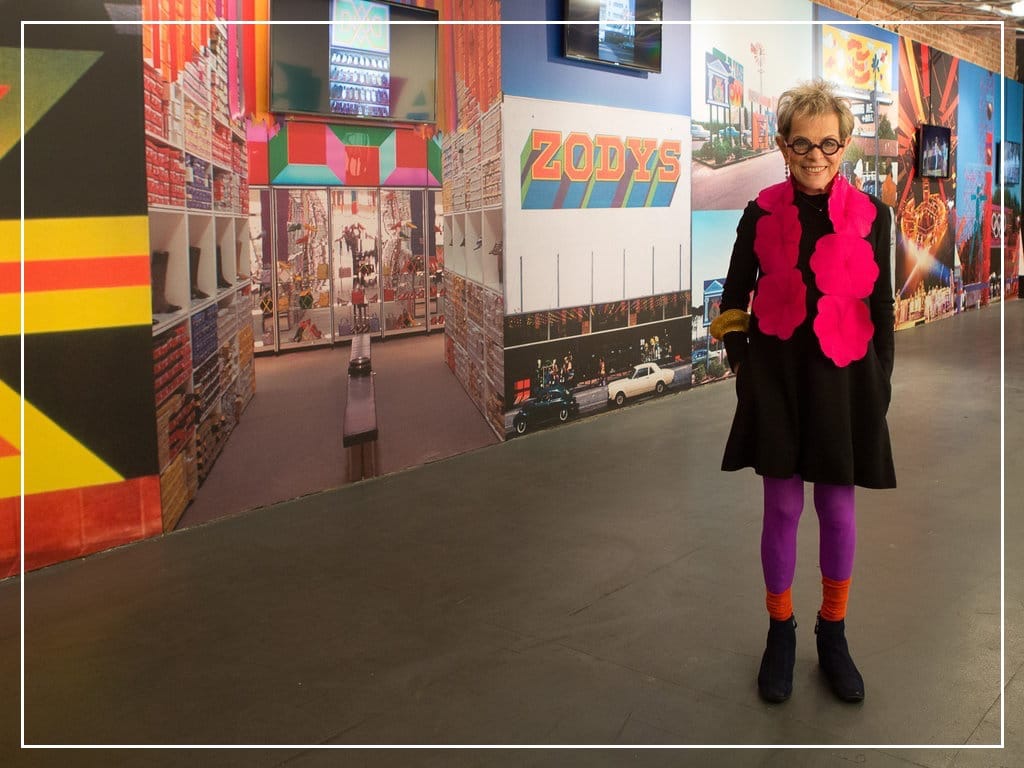
For those of us who were lucky enough to know her work — and her blue fur boas and her Rudi Gernreich dresses — you can see that it is that same attention to detail which drove all her creative decisions, from her adamant insistence to use LA-specific flowers for the athletes’ bouquets during the Olympics, to always selecting the perfect shade of hot pink.
When I wrote a story for the New York Times about the opening of her retrospective, "Deborah Sussman Loves Los Angeles," one thing she said still resonates with me:
“Isn’t this something?” Sussman remarked, her turquoise-lined eyes glittering behind purple-framed eyeglasses. “All my life, I was a hard worker, and I would add that much of the time, I loved what I was working on.”
I hope one day I can stand in a room looking back at my life like that and think the very same thing. I think she would really enjoy me sharing some of these never-before-heard tales about one of the things she loved working on the most.
AW: I did record a little bit of when we did the event at the gallery, so I do have a few things that you were saying that night, which was fun.
DS: You know, all of us who were part of putting it together, we were all drunk. I think it was mainly because Barbara [Bestor] invited us to Musso’s and we were all having martinis, and there were some people there that didn’t really drink who were at our table. The rest of us got smashed.
AW: That’s how it should be. You were celebrating!
So, I’m going to take you back to like five different moments we can use to tell this story, and the first one is when you received the call, when you found out that you were being tapped to work on this project.
DS: Well, it started not with a bang but a whimper, because we had thought that we were appropriate to work on the Olympics. However, before that all happened they had told us — I don’t know how much detail to go into — that it was all given to John Follis and Robert Miles Runyan. Robert Miles Runyan did the “Stars in Motion,” and then they were going to give all of the environmental graphics to John Follis, who was older than me and he’d been a mentor mainly in terms of how you do environmental graphics, and what are the steps, and what’s the fee and constraints. He was a mentor that way, and he had a name as a designer, and he was part of the then-old boys club, of which I was not.
AW: And how old were you at the time?
DS: Well, I was born in ‘31 and we’re talking about ‘82, ‘83, so I was 51-ish. And then along came Jon Jerde. Jon was a great strategist, and we started with the best client in the world, Harry Usher. He was an entertainment lawyer; he was charismatic, handsome, intuitive risk taking, charming, and Jon had met Harry Usher and talked about the impossibility of building anything and the absurdity of trying to build a stadium or anything with just a couple of years and no money.
And Harry went along with Jon’s concept. That was to take existing facilities and adapt them for the needs of the Olympics, so where you wanted big structures, the idea was use ordinary building scaffolding, and where there were intimate transactions with cashiers and tickets and so forth, that could be done in tents rather than in solid buildings. And so it was making use of the constraints in a very brilliant way.
And so Jon’s office was working on ideas like for — I think in the beginning it might have been, well, I’ll have to remember the sequence, but anyway the idea of using bar mitzvah tents and tweaking them, and the building scaffolding, and chain link fences, fencing, because everybody was all freaked about safety.
So there were all these more or less disregarded materials used for other purposes that were temporary, and the Olympics is a temporary event. So Jon came up with the strategy — it wasn’t even adaptive reuse; it was using materials that were meant for one purpose for another purpose, so Harry loved the idea.
While that was happening I had been told, of course we probably called this guy, Dan Stuart, and he said well, thanks for your call but we’ve given everything to John Follis and Robert Miles Runyan. Well, that combo didn’t sit well with Harry Usher. Jon was looking at it in a more or less logical somewhat conventional way. Jon had met us, and me, and he’d already started to talk to us about — or maybe we were already working on Horton Plaza — so we finally got an assignment and the first assignment was only to do the signing plan for the UCLA Village on the field, so the athletes shouldn’t get lost. And Jon said to me, don’t even think about that. You dream, dream, see the big picture, and I did.
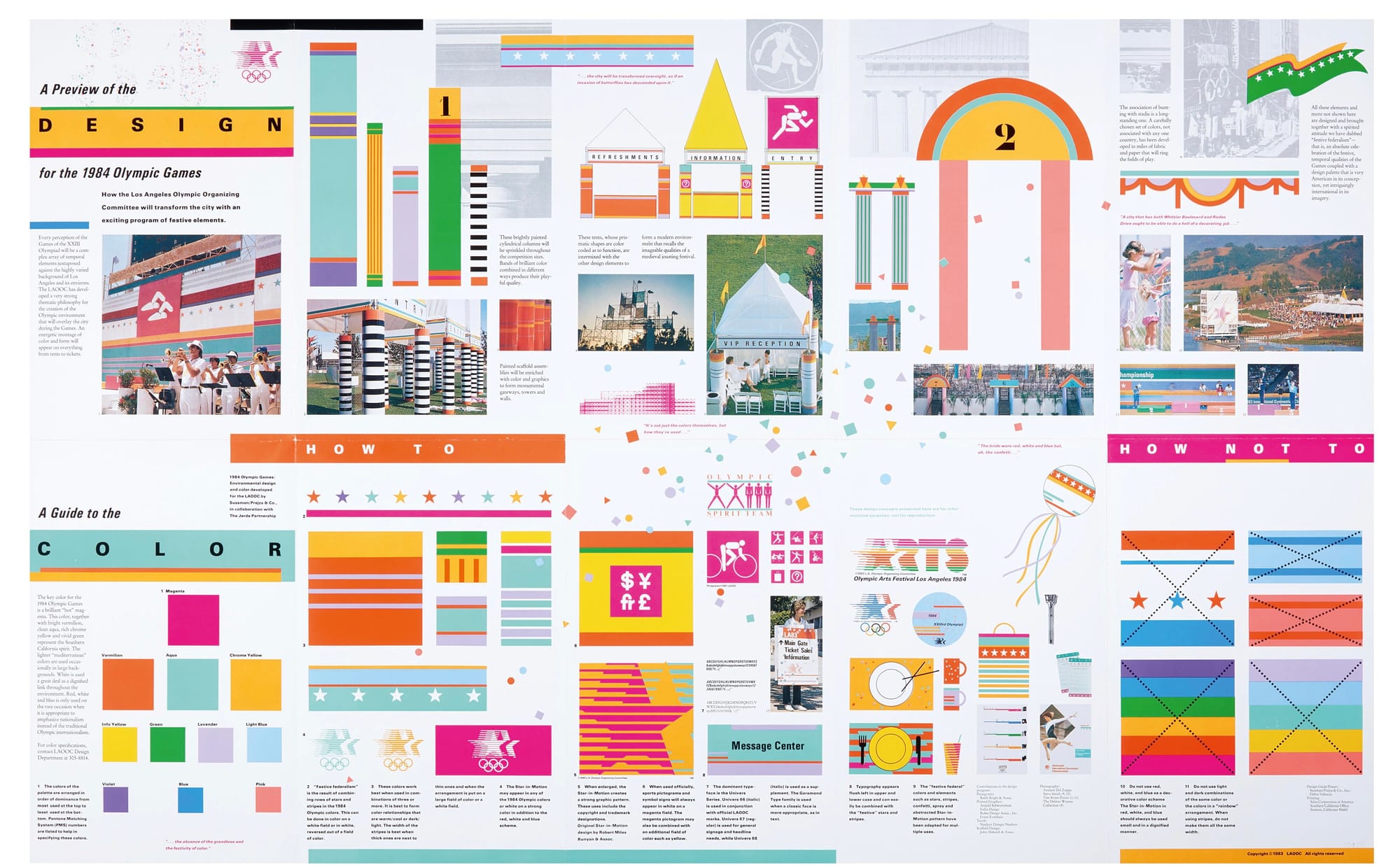
Somehow I saw in my head the sky and the ground sprinkled like confetti — sprinkled with all magical stuff that shimmered and that expressed joy, excitement, you know, expressed the goals of the Olympics. I have this thing in my head, and it came out. First of all, everybody was crying for a color palette, we need a color palette, and John Follis had already started a color palette but it was very sort of academic and it certainly didn’t have magenta and those crazy colors. He just thought there should be bright colors in the foreground, I think it was, and Mediterranean colors in the background.
Well, when I involve myself with color it’s conceptual. I’m very intuitive, however, but when it comes to color I’m also very conceptual. I don’t just choose colors I like. I choose colors that are appropriate for the program at hand. So I went to the paper drawers — this is so long ago, can you imagine? I’m talking about early ‘83. Nobody used computers. We had paper drawers and we cut up paper, my favorite activity, cut up paper, and I had a mania for collage which was nourished in my years with Ray [Eames] and with Sandro Girard. And so I pulled these colored papers out of the drawer and they turned out to be the very colors that we used.
AW: And you said they were papers you’d collected?
DS: Well, mostly those papers were solid colored papers, but I also have a paper collection of rarer papers, but that’s how we did color. So I pulled out these colors and I began to play with them, and they were the colors I had observed in celebration and areas of celebration along the Pacific Rim — Mexico, Japan, India, and little bit further away, China — the colors, basically, of the Hispanic communities that impact Los Angeles, and the Asian community.
We have a vast collection of photographs of Mexico, India, Japan — that’s just FYI. Once, when the Olympics were over, we were invited to a conference in Mexico and we went to Mexico and Paul took pictures of fields of flowers, magenta mainly, that were in the Olympic colors, after we had done. So, had I never been at the Eames Office, had I never known Alexander Girard, known as Sandro, I don’t know what I would have done, but nobody else in the world ever would either.
While it was going on, there was [Richard] Koshalek and the head of CalArts. Koshalek was at MOCA and — it’ll come to me — and Koshalek came around while we were working and he said it’s going to get the world’s applause, and it did. But he said that while we were working in this big warehouse.
AW: That’s right. Tell me how you worked, when you had the team assembled.
DS: Well, Robert Fitzpatrick is the name of the head of CalArts who came along and said, he saw what we were designing and he said, I want something of that on every one of my forty-eight, whatever it was, arts venues, so we did that, too.
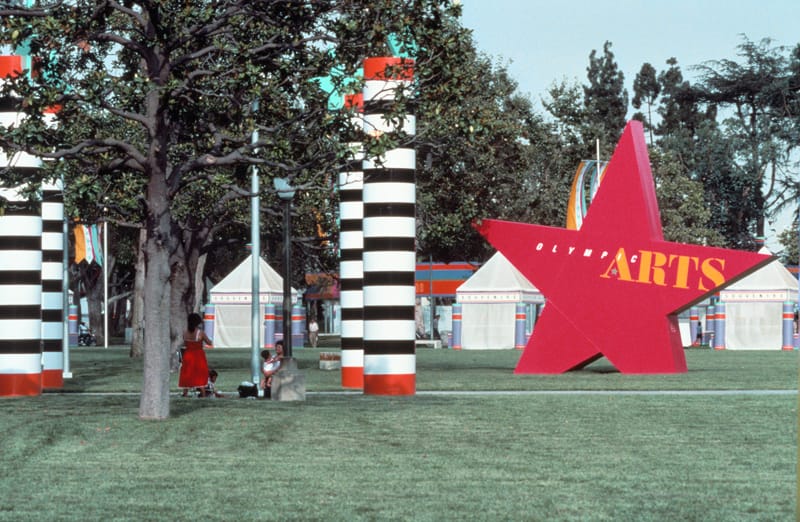
So in the beginning, the committee was on the UCLA campus, and then it moved to this building where SCI-Arc used to be. Anyway, they wanted us designers to come and work in their headquarters and Jon said no, we have to have our own space. We have to be free. So they rented a warehouse on 6th Street near downtown. No, it was on 8th Street.
AW: So, on the other side of the 110 from downtown?
DS: I think it may have been just this side of it. But it was this big space, and I’ve got lots of stories about that but I don’t want to tell anything that’s going to be bad for somebody. So what we had was sawhorses, and it was all temporary, like the Olympics. And Jon rightly strategized for all the Olympic design activity to have them under that one roof. And it was fantastic, because I could walk around, I mean there was a whole group of graphic designers and architects and industrial designers. And we at the peak numbered 150, but in the beginning it was just a few of us rattling around. And then we hired more and more people, and nobody had a budget, nobody knew how much it was going to cost, but we got paid.
So, that’s what happened, and we gradually, I mean I have pictures of me pointing at some presentation board, you know, so people came and worked there. It was in the open, so that the leaders could see what people were doing. And everybody had goodwill. We were working just like an athletic team. The goal was further, higher, faster, and that’s how we felt. And our group grew and grew, and it finally got organized into teams of people that would make sure that the stuff that was built and in rolls and everything came to 8th Street and went out to the right venue on the right truck.
Designers were doing this, not just designing, and that was one of the things that was so extraordinary and so fascinating, that people kind of — there were leaders of different components of what needed to be done, and there were people doing it, and we were all living under the same roof.
AW: And just the fact that everything was manufactured here, everything was being produced, it was all local.
DS: Well, it was. At one point the committee said we’ve got all our sponsors lined up now. That was Peter Ueberroth’s outreach program, and money is no object. But by then it was so late in the game, and almost every supplier west of the Mississippi was working on the LA Olympics.
I’ll tell you another funny thing. When we were in 8th Street, maybe there was a conference room area, maybe not, but we put up this huge, huge piece of photo paper, floor to ceiling, and it was going to be the outline and the schedule and the spreadsheet for everything. Well, we got as far as the first week, and then nobody ever filled it out. Nobody knew what to write. We just did, we did it, and we made it, and we got paid. Could that ever happen now? I doubt it. I don’t know, maybe.
AW: What was one of the moments where you were challenged, and I’m sure there were many, but when you were kind of maybe scared that it wasn’t going to be pulled off, or the drama moment.
DS: There were mistakes. I did a boo-boo. But before I forget, I just wanted to mention to you, and I don’t know if this should be on the record or off. This should be off the record.
She tells me something off the record.
DS: Sometimes you get so passionate about every aspect of what you’re doing, at least I do, I get so emotionally involved and I want everything to be just right, and exactly just right, and things were coming along very well. So, there was a design that was supposed to be attached to the walkway to a bridge, above the walkway at the UCLA campus that separated the field from the village and the buildings on the left. It was the major walkway and there was this bridge, and the bridge had chain link fence on it. And so designers were making this beautiful mural that would have to be sewn or held together out of the different colors of nylon. And it was such a beautiful design.
So I went there. It was going up. It was in the evening, and the colors looked glorious, but all the pieces of nylon, the edges were crooked and sagging and I made them take it down. And I was saying to one of my lieutenants; let’s just make it out of board so it’ll be straight. And the awesome shots of it, unfinished in the nylon, like stained glass, glorious colors coming through, and I made them take it down. Isn’t that awful? Awful, but that’s in the fever, I was having a kind of fever.
AW: Were you actually out there going to every site and looking at things?
DS: No, there were too many sites too simultaneous, so we had teams going to different sites. And Paul and I and Jon decided that the sites that were the most feasible for us to affect, and will be the most seen, were the ones that made our core group’s attention, like the stages at UCLA Village and USC and the USC Village in UCLA, and the swimming venue.
And everybody was great. Everybody was great, except there’s always somebody, one or two people, you give them 13 or 14 colors and that’s not enough, they have to get some more colors of their own. That happened very briefly and not very seriously.
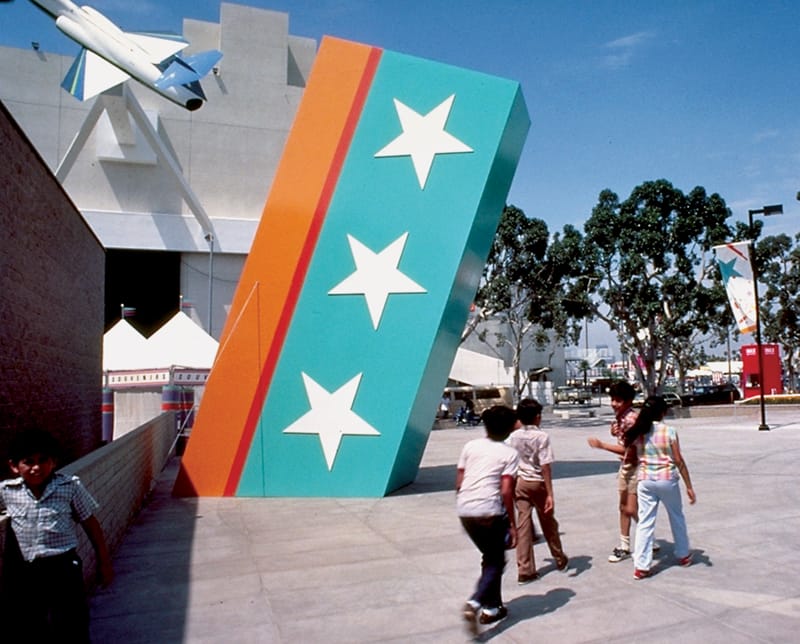
AW: So as you’re getting closer to the time and you have so much less time than Olympics now, like it’s crazy how much more time they get to do things.
DS: Oh, they did before, too. Other countries had like ten years.
AW: So why was the time so limited for LA? They didn’t have the money?
DS: Maybe Paul remembers. I think it’s partly because it wasn’t going to be handled by the feds. It wasn’t getting any government money, so that means all the money had to be raised, but the work had to be done while the money was being raised, and that’s why everything was on the cheap, on the cheap, on the cheap, and at the end they said you can spend any money you want, and it was too late.
AW: Did you ever get to take advantage of that part of it, maybe for the opening ceremonies?
DS: The opening ceremonies, oh, the ceremonies is a story all by itself, and it’s not very pretty. David Wolper was in charge of ceremonies, and he did everything he could to ignore what we were doing. We had this design guide and it had all the approved colors on it, and even though there was a red and blue, it had next to it approve colors, disapprove relationship. The disapprove relationship was red, white and blue, but David Wolper did everything he could to make the ceremonies red, white and blue with that Sam the Eagle and this fake rocket, and it couldn’t have been more corny and more different from everything else in the Olympics.
AW: But were you behind when everybody held up those—
DS: No. That’s a classic staging trick. We were not involved in that, and I don’t even remember whether David made the colors red, white and blue. There’s a picture of us all looking at the Coliseum in the Design Quarterly.
AW: Okay, so there was that tension I guess between the red, white and blue.
DS: Well, that is the only instance that I can remember. Sam the Eagle was a fait accompli long before we were hired.
AW: Do you remember a moment where, opening ceremonies happens, whatever, did you remember a moment where you could sit back and actually enjoy it, enjoy what you had done?
DS: It was hard, because everything I saw, if only it could be this, or if only we had had another one of those over there. But it was pretty exciting. I mean, it was almost like I was in a dream.
AW: Well, it was your dream. Were you seeing your dream coming true everywhere you looked?
DS: Yeah.
AW: The confetti especially. There were a few moments I feel like where I saw videos, the confetti or something, or it just felt like confetti itself was sprinkled across the city. That’s very much the way it looked.
DS: Well, Jon invented this phrase, "An invasion of butterflies." And he also invented "festive federalism," because we had inherited the story motion. If the story motion was in use, like on a moving vehicle or on a fast moving screen, it blurred. But if you took the idea of the stripes and then you did playful things with them, you did other things with them in the different colors and not in red, white and blue that became a language that Jon Jerde called festive federalism, and he said that about what I was up to.
AW: What was favorite small detail that maybe people didn’t notice, that only you would notice?
DS: I’ll tell you about two things. One was that there are people who work for the Olympic committee that get involved with the Olympics hoping and thinking and experiencing that it got them a lot of money and they got some notice. So there are these Olympic committee groupies that travel around, and sometimes we saw their picture in the paper, claiming that they did what we did. We never even met them. But we did meet one of them, and this guy was English, I believe, unless he was German.
And we came up with the idea that the winners would all get appropriate local, exotic flowers, including birds of paradise and other southern California or California kind of florae. And this guy said, you must be crazy. Athletes get roses, and that’s what we want them to have. We? He. So we went ahead with our plan and there are all these pictures of the athletes with exotic flowers and birds of paradise, looking great. We have pictures. Sports Illustrated mentioned the flowers.
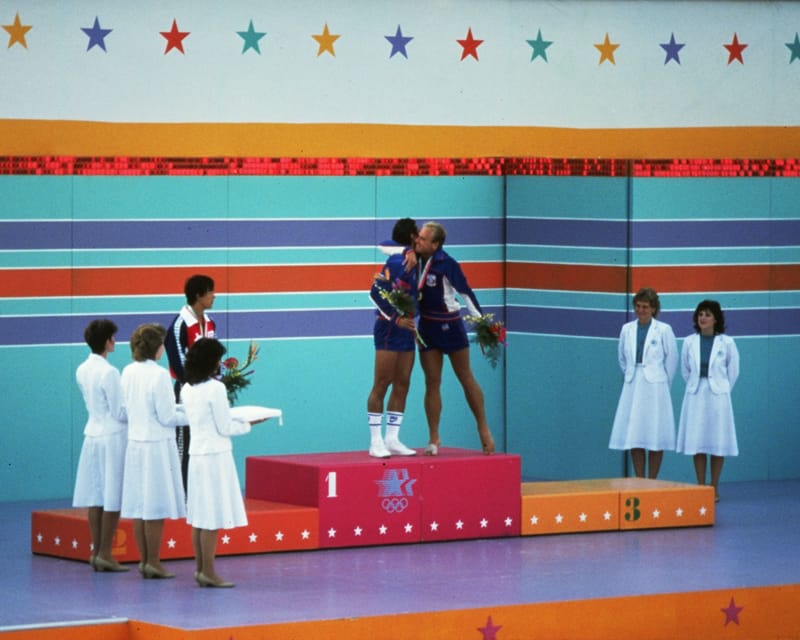
AW: That’s awesome. That’s the kind of detail I like! You knew it was part of your style guide, you knew that would exactly fit particularly, and somebody wouldn’t understand that who didn’t have that same level of finesse.
DS: That triggered another memory that I wanted to tell you. One day, working down at 8th Street, I was sketching. I sketched; we didn’t have computers, it was all done by hand, paste up, and so there was a picture of the hurdles and athletes jumping over them, and part of our mission was to identify everything that we possibly could as part of the LA 84. So I’m sketching on the hurdles, and I’m sketching that LA 84. It fit in that Corbu stencil type on the hurdle.
And Harry Usher came walking by and looked at what I had done, and he said, this is going to be very useful to us. And one of the reasons why it’s so useful and so ubiquitous is that it didn’t have those lines in it that the "Stars in Motion" had. It was very bold, very direct; it said LA 84, and that LA 84, became the name and everything it could be applied to, it was.
AW: So that actually became the name of everything.
DS: That little sketch, this big. I had another story, too. When we began to work on the village and then everybody began to say, well what are the colors, what are the colors, there was a young man in our office of Asian descent, and he was very talented, and he said you’re not going to use those colors for the Olympics. He said the Olympics are pure, they’re like religious. They should be white. Well, his desire was lost in the avalanche of color.
AW: But there was a lot of white, it felt like.
DS: Well, here’s another story — I mean, I can go on for the next two weeks with stories. I don’t think I will, though.
AW: There was a brightness, that everything didn’t have a lot of –
DS: Well, for example, if you’re not sure what colors things are going to eventually need to be you can start off with a blank canvas, white. So one day, in the middle of all this, the committee hired this construction company to help make sure that everything got built, and so we dealt with this guy who in my memory is 8 feet tall but he wasn’t quite that tall, Big Ed. And Big Ed came over to me and he said, we’re going to have chain link over every venue, it’s a security thing, and so we need to know how many miles in each color you want, and we need it by the end of today.
So, you know, make use of the constraints. I just said make it all white and we’ll put the color on it, and that’s what happened. That decision to make it all white was something born out of the constraints of designing for the Olympics with almost no money and hardly any time. But then, we have many examples of graphics and color on the chain link fence, on the white material, because you could put anything on white, and you could leave white. So that’s part of that story.
AW: How long was it from the beginning to the end, the actual games themselves?
DS: The games were from sometime in July to sometime in August. I don’t have it in my head right now but it’s amply recorded, and I also have here the two volumes they make, about such a volume, that the LA Olympics Committee had to provide. Every Olympics has to have a record, and the record is of every venue and how many square meters and who won, and all those records and records and records.
AW: Did you find, because things had to be up for a long time, were things getting stolen, were they getting vandalized?
DS: Here’s a story. In many of the venues there was landscaping, a lot of landscaping, and so what was that landscaping going to look like and what was it going to be? So the landscape architects determined what flowers and plants would survive, and then we got involved with them and then all the plantings were grown offsite and then installed in the Olympic colors in the Olympic designs.
So, some naysayers said look, forget your dream. It’s all going to be trampled and destroyed on the first day. Well, by the last day nothing had been trampled, and nothing had been destroyed. And I think the moral of that story is you do something really good for people and they will respect that. Now, that’s not always the case, but it was the case in the Olympics. And we have photographs of the plantings in use and not being destroyed.
AW: A lot of people said things like that, like it gave a sense of pride that L.A. hadn’t seen before. Could you feel that when it was happening?
DS: Yeah.
AW: Were people saying things to each other? What was the word on the street? I know people were worried about the traffic —
DS: All my cultural friends went to Europe or wherever, and all the culture of Europe and of Asia was right here.
AW: So people left town because they were so scared.
DS: A lot of people left town. Was the previous one in Munich? I can’t remember now. But everybody got lost. It was a disaster. So everybody knew that in the beginning, and that’s where John Follis came in because he was well known for signs. The biggest challenge was going to be signing and people getting lost. Well, nobody got lost. It was easy, you know, we did the banners, there was David Meckel who fought with the DOT and the MTA and all of those things to get them to allow us to even have a little piece of the Olympics on some of these signs on the freeway.
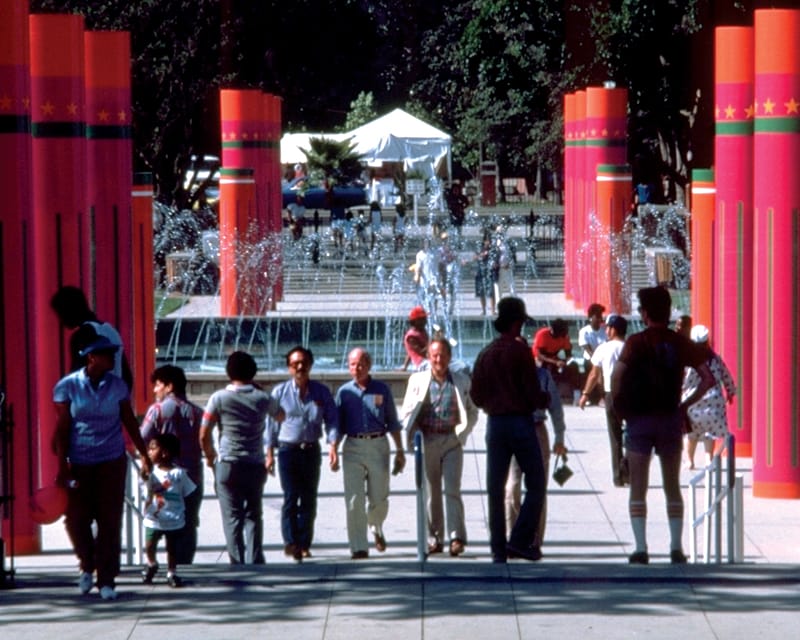
AW: So people definitely felt like it was their civic pride swelling during this time.
DS: Yes, I think so.
AW: And a lot of people said that it made the city feel smaller, it made it feel —
DS: Accessible.
AW: Accessible, yeah, I mean were you sad that it was temporary and that these things had to go away?
DS: Yes. Well, the Coliseum is a good example. When we were doing the Coliseum, the Coliseum commission, in all its wisdom, so distrusted the Olympics Committee that when the committee found the money to at least paint the coliseum and do a few other things they made the committee guarantee that they would bring it back to its pre-Olympics condition. And then when they saw what we had done, the Coliseum wanted to keep it but it was too late, it wasn’t built to last.
You know that a number of the people who worked on the Olympics are no longer with us. Jon is barely with us, from what I understand, barely, and he hasn’t been communicative for quite a while. And there are still people around who claim they did what they didn’t do. You know, they were part of it.
AW: We know that LA is going to be bidding for 2024.
DS: Do we know that for sure?
AW: The guy that was at your event came up to me and gave me his card and said that he was the person from whatever, and then I also got an email from someone else saying that they’re definitely doing it in ‘24, I think.
DS: When did you get these?
AW: One guy reached out to me after I wrote an article, probably a few months ago, right after your show went up, and then the guy at your thing was like, yeah, we’re bidding, it’s happening.
DS: At which thing?
AW: At your event. I can give you their names.
DS: I have the name of somebody, the guy who brought me up to say hello to Eric Garcetti. But at the same time, there’s another thing going on and that’s the LA World’s Fair, and I keep getting emails about committees meeting and yada-yada, and between a World’s Fair, which is basically a thing of the past, and Olympics which is a thing of forever, the Olympics is the way to go. Well, I would certainly be happy to meet with them and talk with them and so on.
AW: Give them some ideas.
DS: Yeah, well, I think Eric Garcetti is just great. We are lucky. You can print that.
AW: What’s your reaction when you see other Olympic games now when you have watched the millions of Summer Olympics since these went up?
DS: First of all, my mind was blown with Beijing. You could never do that here. That level of discipline and conformity among that many people, it was just fantastic. With London, it’s a weird story because they ended up using my Olympic LA 84 palette, and there are pictures of the London Olympics with a lot of magenta and a lot of aqua. And I thought, oh, so this is a picture of LA, and it wasn’t, it was London 2012. And I tried and other people tried to get into a dialogue about why they used the LA colors and it never really happened. But I would never have used those colors to represent London. I can’t give you the answer of what I would have used right now, but they wouldn’t have been Pacific Rim, southern California colors.
AW: I remember when they revealed it, and it’s so funny now because I remember writing about the London stuff so long ago and when it happened it didn’t feel that radical at all. But I think it was a lot of shock value, I think a lot of what they were trying to do was surprise people and not really make it much about London, just get a lot of attention.
DS: I thought the ceremonies were just enchanting, you know, queen and all those — I thought the ceremonies were absolutely just right on, because with the memory of the mass discipline of Beijing, the fact that they made it so quirky, and English humor was just the right way to go, is what I felt, and not make it pretentiously monumental.
AW: What did you feel the personality that was being put forth from LA was? Because you’ve mentioned two really interesting things about those, what was the kind of global opinion of what LA was putting out in ‘84? How were we perceived back then?
DS: That’s a good question.
AW: Do you think the Olympics changed that?
DS: Oh, I think the Olympics definitely contributed to put LA on a map that it didn’t used to be on, that there is a flavor here. There’s a flavor of Paris, pardon me, but for comparing Paris is my favorite city in the world, but LA was just big and white and movie stars and not serious, and I think it made LA more substantial in the eyes of the world. I never said that before.
AW: I mean, it was a tough time. There are things that are bad that happened before, obviously, a lot of things had been changing, but it was kind of this thing of optimism we could hold to us. What about television, since it was broadcast so widely? Were you considering that?
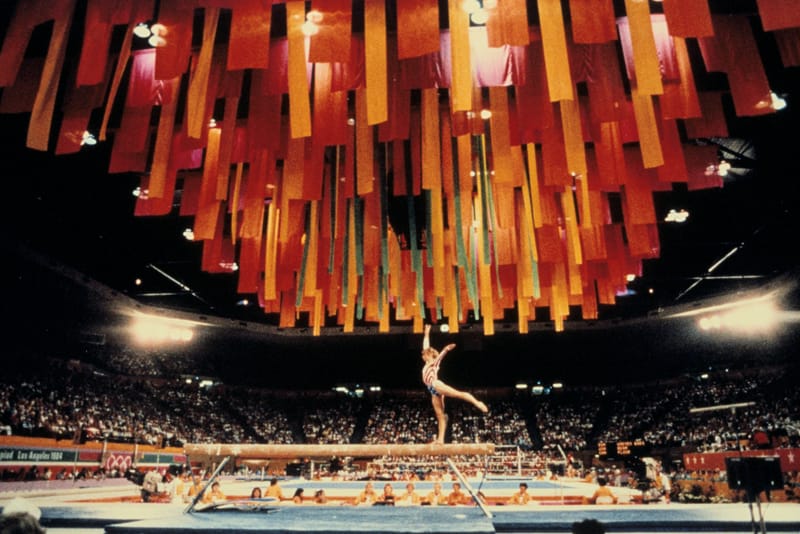
DS: Oh, yes. One of the things that Jon pointed out, and one of the things that ABC — there are millions of people who are going to see this on TV, so it was very consciously designed so that it could be seen on TV. And I remember there were people that worked with ABC camera people and producers to make sure that the camera was pointed at the things — not just at the sports but got the rest of it. And so I think there were people who were saying it was the first time that it was designed to be seen on TV around the globe, and I’m not the expert on that.
AW: I think that’s true, I think it was the first time they had sold the rights to broadcast it and made money off of it, and so it was this amazing media deal and it was exclusive to ABC and all that stuff. So it was kind of the beginning of a media partnership that defines everything we do. And I think that’s true, I think for the first time it was this package-produced show.
Of course it was on television, and the Olympics had been on television before and you could watch it at home, but this was the first time that it was this very polished package that you would tune into and it really made it part of your evening programming, or whatever time of day you were watching.
I think for anyplace to have mastered that, the fact that it was LA was pretty great because hopefully we’d be good at that since we produce so many things here that you’re supposed to watch, so it’s good that we mastered that one.
DS: It’s interesting also to compare some of the ideas that we had for television with Putin’s games, because they took, the designers took patterns from classic — I don’t know if it’s all Ukrainian — graphics and fabrics and all of that, and I thought when you looked at each one of those compositions it was really beautiful, but the way they used them was kind of spotty.
The athletes had these vests that were cut on the diagonal so you saw very little of the pattern. And whereas in our venues the entire screen, the entire field of play was ringed with a continuous design, whereas in Sochi, they were clumped. And I felt that had they been more continuous they would have been more effective and less complicated, because if you have a complex design in a complex shape they’re fighting each other, so there, my Russian friends.
AW: I think the Olympics that had been just before were the Moscow ones, talking about geopolitics, so remember we had boycotted them and then they had boycotted us. Was any of that weighing upon you, or did you feel like it wasn’t —
DS: One of the reasons why Harry Usher was so interested and excited about bringing the design to the forefront was that the games themselves were going to be less exciting because of the Russians not being here. So to him, what our effort was, was also in response to the fact that they weren’t here. I don’t think we would have designed it any differently had they been, but that gave him a heightened interest in the design. 🔥